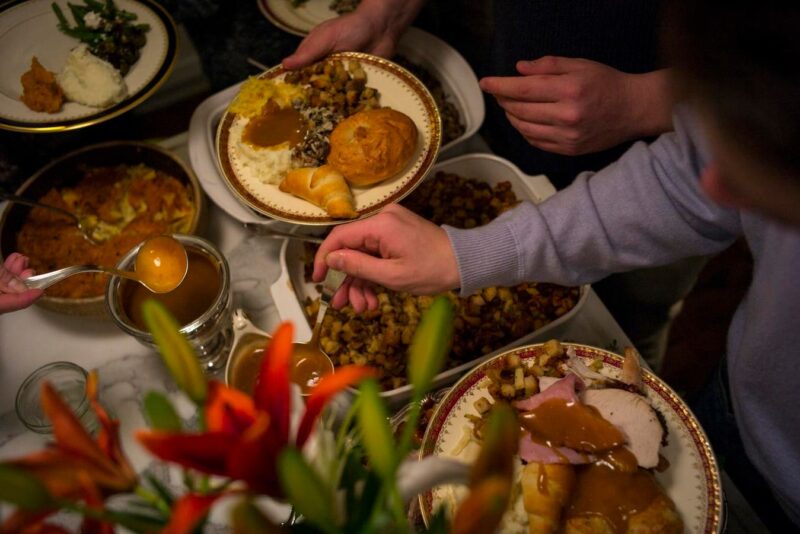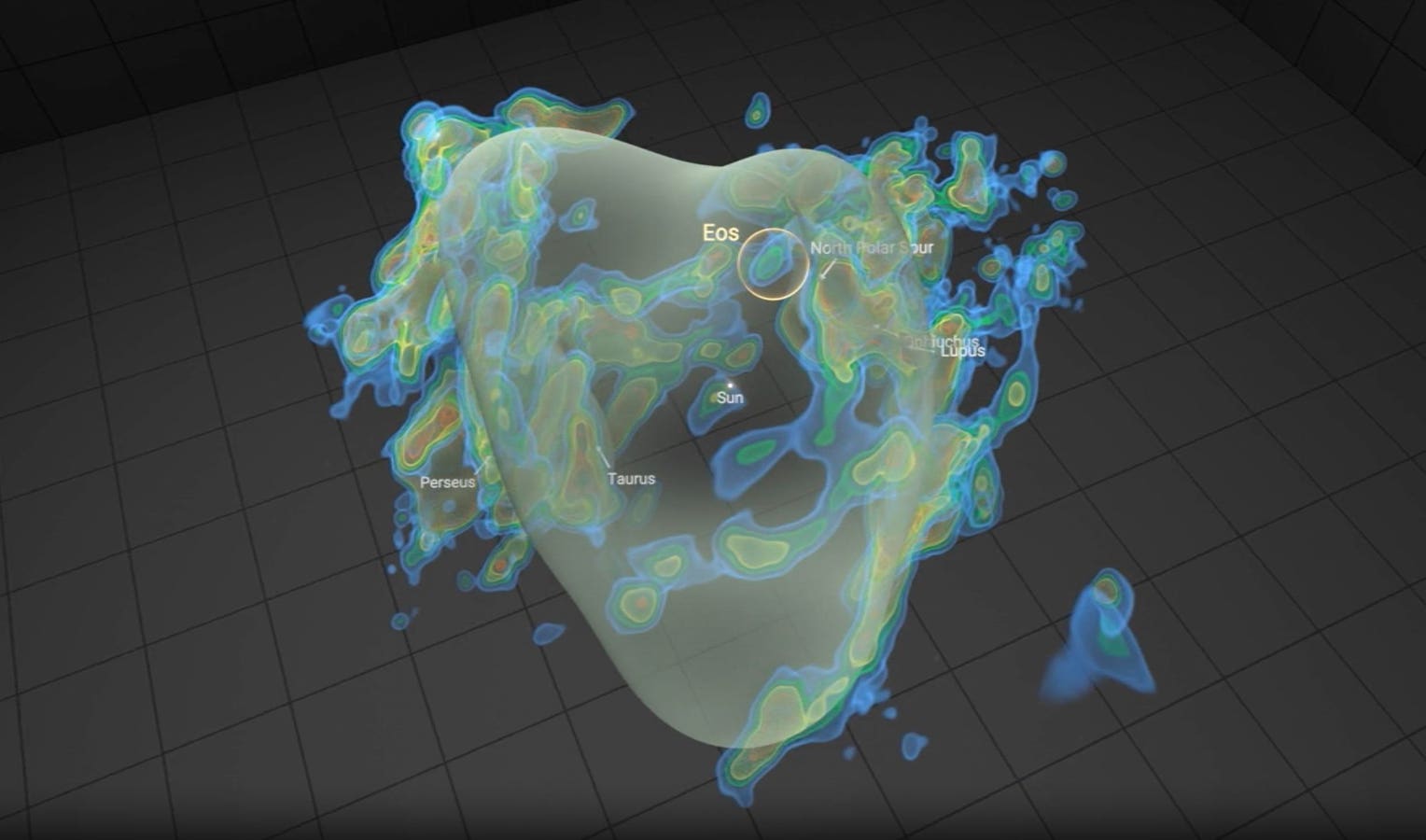On Thanksgiving Day, families and friends gather for a large meal with traditional foods like turkey, and to express gratitude. (Photo by Robert Nickelsberg/Getty Images)
Getty Images
Thanksgiving is approaching, and many families are already stocking up for the feast that brings loved ones together. From the turkey centerpiece to the sides of rice, corn or pasta, it’s a spread of colors. But behind those visible, familiar colors are hidden risks which many of us barely notice—risks that can seriously affect our health and the resilience of the food system.
We don’t typically see these risks most of the year, but at moments like Thanksgiving, they become apparent in prices. The price of turkey is as much as 75% higher than in October 2024, according to research by Purdue University. The media is already comparing retail prices from Walmart to Aldi to give the best insights on where to buy. While these options might help cut the short-term pinch, it is the long-term impact that we need to brace for.
The immediate reason for the recent rise in turkey prices is attributed to the outbreak of avian flu, which reduced the size of the flock and caused supply shortages. What this price rise doesn’t reveal are deeper zoonotic and supply chain risks in the feed-crop system behind your Thanksgiving meal. Here we explore these wider systemic risks through two questions.
Is Bird Flu Only A Thanksgiving Turkey Price Story — Or A Pandemic Risk In The Making?
Bird flu spread in many parts of the US earlier this year, impacting retail prices. Nearly two million birds have been culled in the US since August last year to prevent the spread of the disease. The first case of this flu was reported as early as 1996, but last year marked the first time it spread from birds to dairy herds and also to some humans, affecting over 900 dairy herds and roughly 70 people, with one death. The US government is said to have contained the recent spread, as there have been no new cases, and market analysts are already expecting retail prices to return to normal.
Good news that it was contained, right? At least for now. The bad news is that a bigger problem is in the making. Scientists warn that bird flu, H5N1, is one mutation away from becoming more easily transmitted to humans. These findings, published in the journal Science last year, underlined the need to closely monitor future mutations. The study is widely cited by experts at organizations, such as the FAIRR Initiative—an organization that raises awareness about the risks and opportunities in our food system among investors—to draw attention to the future problems we may face.
The natural question to ask is this: how are governments addressing the issue of zoonosis — the transmission of diseases from animals to humans? Globally, 70% of all emerging infectious diseases originate from zoonotic pathogens, which are germs that can carry diseases from animals to humans. The recent COVID pandemic was one such episode of global spread of zoonosis, which led to the deaths of thousands of people.
There are animal welfare regulations in place in many countries, yet the system is at risk. The way animals are reared in industrial farming setups these days makes them susceptible to disease outbreaks. Industrial farming often subjects animals to conditions such as overcrowding and poor ventilation, which increases the likelihood of stress and contagion. Moreover, breaches of these regulations are commonly observed. For instance, a 2021 investigation by the USDA revealed there were breaches, including disgusting practices like birds being boiled alive or live and dead birds mixed, found in as many as 181 out of 300 slaughterhouses inspected in 22 states.
Earlier this year, a global Pandemic Agreement was adopted by the World Health Assembly after more than three years of work. It also initiated the work on an intergovernmental working group to carry forward the agreement. Although a welcome step, experts such as those at Chatham House, a U.K.-based think tank, are calling it weak and saying that it falls short of concrete obligations; it gestures toward equity, solidarity, and cooperation but stops short of demanding them. At least 60 countries must ratify the agreement to gain momentum which is quite ambitious. Significant questions also remain regarding what countries are actually required to do once it comes into effect after ratification.
Can The Feed-Crop Supply Chain Hold Up As The Planet Warms?
More than half of livestock giants disclose having just one or two suppliers of animal feed per crop, increasing exposure to climate shocks and price volatility. The findings are based on a report by the FAIRR Initiative, released yesterday, that analyzed the soft commodity supply chains of 40 publicly listed protein producers—including giants such as Tyson Foods, JBS, and Marfrig.
There is a heavy concentration of suppliers in just two regions. Asia accounts for a large share of the supplier base for soybeans, wheat, and corn for most of these big producers, accounting for as much as 60% for all three crops. North America is a second, accounting for 20% of that concentration.
It is not just the concentration in two regions that is a cause for concern; 11 out of the 18 companies that have disclosed their supplier information rely on a very limited number of suppliers. Many of these companies that have disclosed information rely on just one or two suppliers for corn.
The findings above reveal fragile feed supply chains, characterized by a dependence on just two regions and a small number of suppliers within them. That is concerning because both regions are highly vulnerable to the impacts of climate change. As Weiming Pu, Senior Analyst and author of the analysis, puts it: ‘Climate shocks are rapidly turning into feed shocks.’ Asia is already warming at roughly twice the global average, with more frequent floods and storms, while parts of North America’s Corn Belt could become less suitable for production.
And because feed crops are a major input cost for these large companies, price shocks can quickly impact their margins. Feed makes up around 70% of total livestock production costs, Pu adds.
Previous studies reinforce the warning signals to the livestock and food supply chain. For instance, a study by the Commonwealth Scientific and Industrial Research Organization drew attention to the link between climate change on the livestock supply chain and food security. Another study, published this year in Food Policy by scientists in Canada, highlighted the high degree of corporate concentration in the agri-food supply chain and its ability to reduce the power that consumers have to exercise their voice. This allows corporations to influence policy decisions through lobbying and indirect measures, thereby weakening broader democratic participation.
There are opportunities to build resilience in the system. Some approaches include diversifying the supply chain across multiple suppliers and understanding how these suppliers manage the impacts of climate change on their outputs, as well as exploring alternative feed ingredients beyond traditional crops. Technological innovations, such as precision irrigation, are also helping to stabilize yields and water use, particularly in regions facing escalating heat and water stress. Encouragingly, the report finds that more companies said last year that they are committing capital to build resilience in their feed sourcing compared to 2022.
So, this Thanksgiving, as you sit down to enjoy your colorful meal, think of not just what is in front, the turkey and the sides, think also of how there are wider sustainability risks baked into that meal, of where we are and where we need to get to, to build a more resilient food system.









